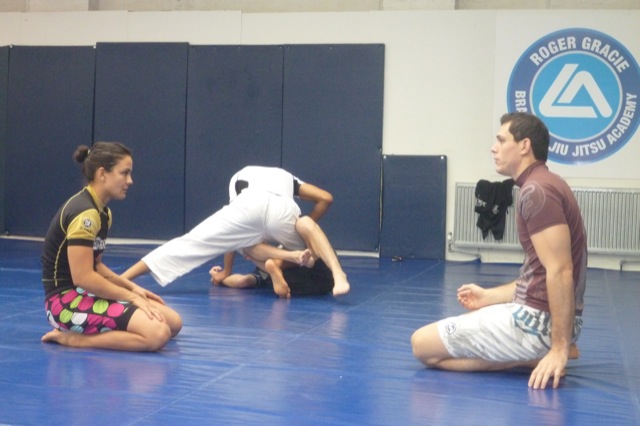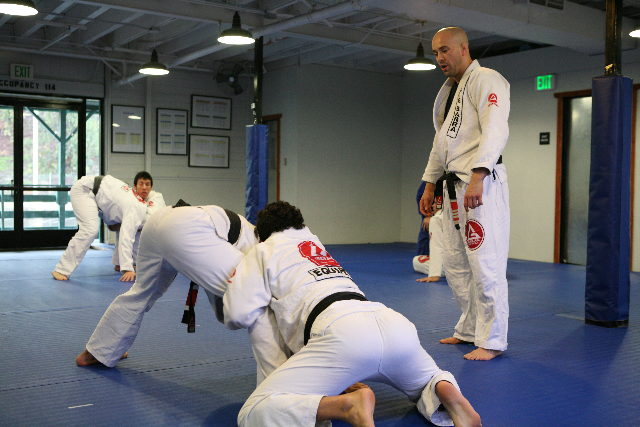He collects unprecedented achievements in Jiu-Jitsu, but his background is little different from countless other blue belts around the world. At the crossroads, though, he always chose the right patch, as this article published in GRACIEMAG after the 2009 Worlds explains to readers.
The 27-year-old fighter’s eyes are hazel and weary. Roger Gracie is the black belt with the biggest buzz about him at the moment, undefeated for one year, having submitted every single one of his opponents in 2009. He’s coveted by MMA events, and at September’s ADCC will try to hang on to his title of super-fight champion, worth around 50 thousand dollars for 20 minutes of combat. His voice, though, is in stark contrast with the best phase of his career. He speaks softly, in a tired, far from satisfied tone. Three weeks ago, he came upon a rival that could take on his 1.93 meters and 98 kilos. And now speaks with GRACIEMAG, after finally having put him to sleep.
To see the little Tristan Gracie on the champion’s lap is a welcome surprise. A big guy, the first-time father has a way with his son. He adapted his grip for the new challenge. The joke was, at the Worlds in California, last June, that Roger submitted his nine adversaries so quickly to make it back in time for delivery. Tristan showed at 59cm and 4.1kg and repaid all the affection with endless hours without sleep, fooling mother Anna and the father who, in grappling, is rarely duped. “It’s hard work, you know. Whoever told me all newborns do is eat and sleep pulled a fast one on me,” Roger says, remarking how he had to postpone till September or even October his MMA fight at the American Strikeforce event, the third of his career, his first outside Japan.
“Train a lot, eat a lot and rest a lot” is the motto the Gracie has repeated for years, a routine Tristan’s arrival altered completely. And nor is there any mystery or dramatic turn of events in the trajectory of the two-time absolute world champion, whose numbers may never be beaten.
Roger’s shift in mentality in relation to Jiu-Jitsu, the first crossroads he came upon, took place, as is often the case, at blue belt. His uncle and teacher Carlos Gracie Jr, one of his chief mentors along with cousin Renzo and uncle Rilion, elucidates: “That happens with everybody, because most white belts are kids, and see it as a game. It’s at blue belt that the young person begins to come to awareness and have notions of values – and to think about what they want from the future, what inspires them and what they want to be in life.”
The Gracie started blazing the trail of success at around 15, though. And, in an episode he, himself, considers crucial in his development, Roger went through a period where he perceived his evolution – which transformed into motivation and will to carry on with hard work. “I was chubby and went to spend some time with Rilion in Southern Brazil, in Florianópolis. There my uncle put me on a diet, made me run every morning and I trained with Rolles there. I felt the improvement, saw the benefits. I never stopped,” he recalls.
The good shape, the technique and the motivation were tested on his return to Rio, in 1999. At the tryouts for the Worlds, Roger was back with a fine-tuned guard and was winning. Until, after sweeping his opponent thrice, opening a comfy 6-0 lead, he couldn’t figure out what happened when his rival leapt to his foot and applied a rear-naked-choke on it, crunching everything – a move these days not even permitted in the juvenile division.
“I was disgusted with myself,” he says, with his ever-peaceable demeanor, his nostrils dilating before he speaks, betraying that either a smile or serious answer is on its way.
http://www.youtube.com/watch?v=nIk8XckFH3c
At the Worlds held in the Long Beach Pyramid, where he had his latest and most impressive performance, Roger gave clues as to how he faces defeat. Of the five times he let the gold slip through his fingers, three were brought on by takedowns. He wasn’t pleased at all with them. But, shortly after taking a perfect takedown from Claudio Calasans, in the absolute quarterfinals, where he needed to (as is his custom) come back from behind in a match, Roger joked: “If I don’t get taken down it even takes the fun out of it,” he said smiling to the reporter.
And it’s smiling too that opponents try to come up with a way to beat Roger, or at the very least not tap out to him. “There have been many great fighters, in and out of the family. But what Roger’s doing no one has ever done. He mines the enemy defenses, putting the individual in indefensible situations,” stresses Carlinhos Gracie.
In fact, there were five collar chokes, one guillotine and three chokes known as the ezequiel (forearm choke), when one’s own sleeve is used – and Roger advanced to pass and mount without giving up a single centimeter. “Beyond the perfect technique and weight distribution, I felt like a dwarf fighting him,” says Bruno Bastos.
To Ricardo “Demente” Abreu, his slayer in the super heavyweight final is “very tight and never errs. Roger doesn’t leave any room for you to execute your game.” What most impressed friend and victim in the absolute final Rômulo Barral is Roger’s guard pass. “He traps the opponent’s hip like no one else does. I knew what he was trying for, I understood that I couldn’t give him that space, but he managed. And my choke defense, which works with everyone, didn’t hinder him in the least, I don’t know why. I suspect it’s automatic to him,” says Barral, who held out for 9:31 min.
Weight, height, reach, that’s fine. To his masters, though, his mind is what makes Roger who he is, demonstrate the technique he has, and not be submitted since blue belt, which comes to over one hundred matches. A head and character molded not just in the dozens of championships he’s disputed, but especially in training, at the everyday crossroads in the academy.
Like the evening when Roger went to Gracie Barra, in Rio, too tired to train. Neither friends nor teachers could convince him. It took the seasoned Alexandre “Café” Dantas showing up unannounced for Roger to disappear and return in a blink, with his gi. He wanted to test himself against someone super-tough who wasn’t always available, as he trained in Ipanema. “Folks tend to pick and choose a bit who they train with, and avoid hard-core training. Roger always did the opposite. He would seek out tough adversaries; he’d go after the challenge, the dispute. His strength of will was greater than the dread, that vanity of losing in training to whoever it may be,” Carlinhos winds up.
It happens that Roger doesn’t let himself be satisfied. He may have the most feared guard in the world, the deadliest mount in Jiu-Jitsu, but it doesn’t matter: “I think folks these days are satisfied just not to get swept, or to have one game that’s just stronger. Not me.”
And where is such a mentality forged? In Roger’s case, it was at home. The ones to provide him the most incentive have always been mother Reila Gracie and father/mentor Mauricio Gomes, long divorced. And, while the mother nourished him with affection and tales of grandfather Carlos, the father too sought to teach him a bit about life, baring his weight down on the knee he placed on little Roger’s belly as a form of play.
Better get ready, Tristan.








